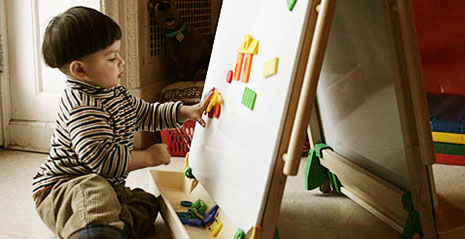The art and creative area
| February 2019Four-year-old Freya surveyed the Help-yourself trolley. She cut a short length of blue yarn and brought it to the table. She took the paper punch and made holes round a sheet of paper, then began to thread her yarn through the holes – but found it wasn’t long enough. Freya cut a piece of yellow yarn which she carefully tied to the first bit. In the end, Freya had used five pieces of yarn, each a different colour, to thread in and out. Only when she reached the last hole and was puzzled how to finish, did she turn to her teacher for help. Next, Freya found a glossy brochure, leafed through it, chose some pictures and carefully cut out and glued them to her yarn-bordered paper. She held the result at arm’s length, studying it with satisfaction.
Freya’s teacher learned how imaginative, competent, and independent a child can be if resources and tools are accessible in the creative art area. Freya showed skill in making and following her own plans – and pride in the result of her efforts.

What considerations should we make in setting up the art/creative area? The art area should be near a sink and have a washable floor. Display art supplies so children can see all their choices and access materials themselves. This requires specialised shelving so items are orderly yet visible. Tables and chairs enable children to focus on their work and art easels should be big enough for large pieces of paper, or even for two children to share. Display children’s finished artwork where they can see it.
“Our task, regarding creativity, is to help children climb their own mountains, as high as possible. No one can do more.”
Learning and development observations
Communication and Language
Understanding
- Children learn to follow instructions about how to set up or clean up creative projects.
- They communicate thoughts and feelings through art.
Speaking
- Children discuss their projects and learn vocabulary to articulate experience.
- They often think aloud while creating, providing opportunity for adults to observe their thought processes.
- Babies might make happy sounds – early language – while engaged with finger paint.
Physical development
Moving and handling
- Young children get involved with their whole body – especially while painting.
- Children demonstrate large motor control through sweeping movements, as in painting.
- Fine-motor control is shown in small movements and manipulation of tools.
- Children explore and manipulate a range of tools: large and small brushes, sponges, print stamps, hammer, saw, drill, scissors, crayons, glue bottle, etc.
- Eye-hand co-ordination develops through painting and drawing.
- Sensory development occurs through working in paint, clay, and other media.

Personal, social and emotional development
Self-confidence and self-awareness
- Babies are pleased when they realise they can create marks, and they repeat the action over and over.
- At the art station or work bench, constructive activity builds self-esteem.
- Children become confident to make their own choices of activity or materials.
- During creative activities, children can say when they do or do not need help.
- Children can take risks, learn by trial and error, and persevere.
Managing feelings and behaviour
- Interacting at the art table or easel, children learn to share resources and respect each other’s work.
- An anxious child may gain security through creative activity.
Literacy
Writing
- Children may add letters or words to their artwork, or may request teachers to write a caption.
- Mark making may signify a child’s signature or ownership of work.
Mathematics
Shape, space and measures
- Children create geometric patterns and talk about shape.
- Mixing paints provides discussion on measure, quantity, and proportion: a little, lots, more, less, two scoops to one cup of water, etc.
- Children often compare size of objects they have created. For example, they draw their family and discuss sizes of family members, or they compare sizes of their wood constructions.
- Through art, children explore characteristics of everyday objects and shapes and use mathematical language to describe them.
- Spatial awareness is evidenced in drawings – the inside of the house for example.
Understanding the world
Technology
- Through using tools such as hammer, saw, and drill, children start to comprehend cause and effect, mechanical forces, and physical properties of matter.
Expressive art and design
Exploring and using media and materials
- Children explore a variety of materials, tools, and techniques, experimenting with colour, design, texture, form and function. For example, they are excited to discover what happens when they mix blue and yellow paint.
Being imaginative
- Children creating 3D models out of clay, wood or recycled objects are developing abstract forms of representation.
- Children represent their own divergent ideas, thoughts and feelings through imaginative creative innovation.
This article is adapted from a chapter from Play and the revised EYFS, © Community Playthings, 2015.







